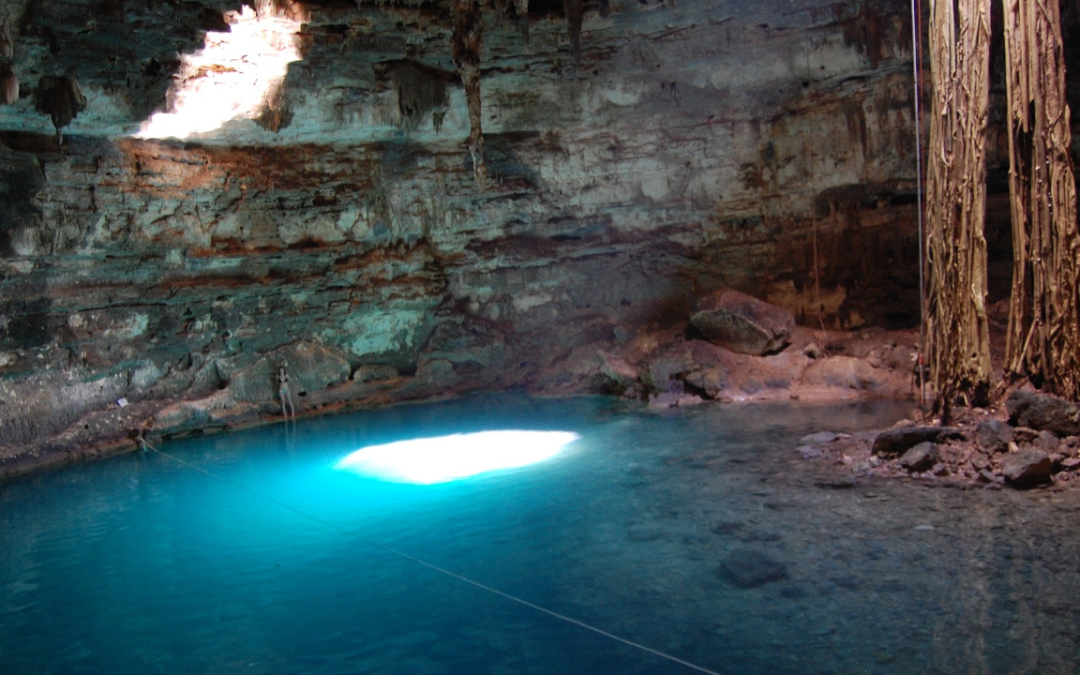In northern Mexico is the world’s most dangerous hole. Known as Zacaton, it is noted locally for the islands of grass that float freely on it’s surface. Essentially it is a self contained lake, stretching deep underground. Zacaton is thought to be the deepest underwater sinkhole on Earth, with a depth of 1,112 feet. But until 2007, this depth was not known – and it’s seemingly peaceful surface has lured people to a horrific death.
One of the many things Mexico is known for is it’s Cenotes, natural sinkholes filled with water. Often they are natural beauties – blue wonders shielded from the outside world by surrounding rock. And so they entered into mythology, seen by some as gateways to the underworld. On the other hand, they provide access to groundwater – especially in the Yucatan, where 10 thousand cenotes can be found. Treated with a mix of fear and worship, many Cenotes remain mysterious places – and until quite recently, Zacaton was one of the most mysterious.
The Mystery Hole
No one knew how deep it was, or what kinds of danger was hidden within it. So in 1994, two cave divers set out to fully explore it’s depths. Their ultimate goal was to set the men’s diving record, and descend to 1 thousand feet. They were Sheck Exley and Jim Bowden – both experienced in their fields. But Exley was the senior partner. For decades he had pioneered diving techniques, and explored most of the world’s well known underwater caves. He was also the first person to dive below 800 feet – something only 35 people have ever done.
So Jim Bowden could not have wished for a better diving partner to explore Zacaton. After months of careful planning, they began their descent. For safety reasons their dives were done separately, but at the same time. So they were around 30 feet away from each other, but connected by the guideline – a rope to help divers in low visibility. Descending at a rate of 100 feet per minute, all was going well at first. But on reaching 700 feet they slowed down. Experience had told them this depth was dangerous. The amount of pressure can cause physical damage to tissue, resulting in all kinds of injuries.
There is also the risk of high pressure nervous syndrome – a condition where divers physically convulse and lose control of their breathing. It is usually caused by descending too quickly. But even when precautions are taken it remains a risk. So any diver who goes below 500 feet can get it.
Down Zacaton
At 800 feet all was still going well for Jim Bowden. But he realized Sheck Exley was descending at a much faster rate than they had planned. It was alarming to see, but there was nothing he could do. Besides, his own oxygen supply was running low. So he aborted the dive and headed back to the surface. After the slow rise to readjust to normal air pressure, he began to worry Sheck Exley would not survive… and he was right to worry. It took two days for Exley’s body to be recovered, and the cause of death has never been determined. Despite cave diving being incredibly risky, some use the death of Exley to argue there is something uniquely deadly about Zacaton.
It was later found that the water at extreme depths of Zacaton is acidic, and contains clouds of hydrogen sulfide, which is highly toxic to humans. It’s like the deeper you go, the closer to hell you get. This is simply because the cenote was formed by volcanic activity – but you can understand how people once saw it as a place of evil.
Other Cenotes
A lot of cenotes had ceremonial importance too – like this one further south, which is full of human skulls. Just outside the heartland of the Maya empire, it has long thought to have been a sacred site. But it was still shocking when researches found the sinkhole was littered with bones. It seems to have always had a gruesome reputation, but until the study a decade ago no one knew why. Legend tells the sinkhole is cursed, that it is guarded by a demonic being – a gigantic feathered serpent with the head of a horse. Perhaps the skulls are all that remains of the demon’s victims. Or maybe a cultural memory of the cenote as a graveyard inspired a strange legend.
Either way, it’s kinda creepy – just like your dad. A lot of the skulls are misshapen. Some are flattened at the top, as if their head was bound from a young age. Other have holes in their skulls that were clearly drilled. But they’re thought to have been drilled after death. It’s unknown how many people were thrown into the cenote, but there is a variety in their causes of death, so they were likely not sacrificed. One theory is that they were nobles, and that being buried here was a great honor. Even today, people often warn their dumb children not to go swimming in the sinkhole, fearing their bones will join with the others. And this is just one more example of a cenote said to be haunted. All across central America are absurdly creepy holes.

